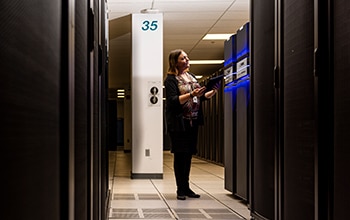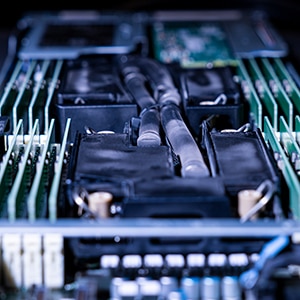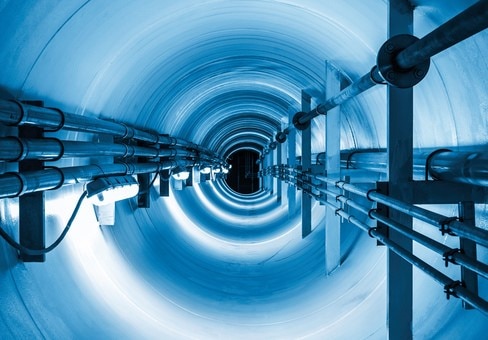
Oct 29, 2025 | Case Study | 8 minute read

Oct 29, 2025 | Case Study | 8 minute read
“AI and sustainability are increasingly intertwined as the demand for advanced digital solutions grows alongside the potential environmental impact.”
Artificial intelligence (AI) and machine learning (ML) have the potential to transform our world for the better, but their rapid expansion is accompanied by a growing environmental footprint. This is notably attributed to the significant energy and water demands of large-scale data centers and the resource consumption associated with hardware production.
However, materials innovators are developing solutions to help address these impacts by extending performance longevity, improving energy efficiency and supporting the infrastructure resiliency of the AI ecosystem. For example, through advanced materials science, Dow offers technologies that enhance thermal management and reduce energy consumption in data centers compared to those using air cooling for thermal management, helping to curb greenhouse gas (GHG) emissions.
The interconnected global network of technologies, data centers, infrastructure, organizations and processes that take part in the development and use of artificial intelligence is increasingly referred to as the AI ecosystem.
These efforts exemplify how targeted innovation can address the environmental impact of AI, paving the way for a responsible and sustainable digital transformation.

The environmental impacts of AI extend across the entire lifecycle of AI systems, encompassing aspects like energy and water consumption and waste generation.
Data centers that power AI operations consume substantial amounts of electricity. Their global electricity consumption combined is expected to be close to 1,050 terawatt-hours by 2026. To put that into perspecive, if data centers were a country, they would be the 5th largest energy consumer globally—less than Russia but more than Japan.1 This energy demand can result in higher GHG emissions if the energy is primarily sourced from fossil fuels.
In addition to energy, AI systems also consume water, primarily to cool data center operations. Projections for data centers’ global combined annual water use could reach 4.2 to 6.6 billion cubic meters by 2027.2 It would take the entire city of London over 4 years to use that much water based on the city’s current consumption.3
The rapid pace of technological advancement can also produce more electronic waste when devices and components become obsolete and are replaced to run more sophisticated AI models. The hardware and other equipment that is used to train generative AI models and run AI applications could produce up to 5 million tons of electronic waste by 2030.4
Addressing these challenges is vital for ensuring that the benefits of AI are not undermined by unsustainable practices—guiding both industry leaders and policymakers toward sustainable approaches.
A significant amount of electricity is needed to train and run advanced AI systems. Notably, cooling systems alone can account for up to 40% of total power consumption in AI data centers5, especially in high-density server environments. This can compete with existing energy demands. Addressing these issues involves improving algorithm efficiency, using renewable or clean energy sources, and developing more energy-efficient hardware solutions.
AI systems consume significant water resources primarily for cooling data centers and the energy generation facilities powering the infrastructure required for large-scale computations. As AI adoption increases, managing and reducing its water footprint is crucial for sustainable development.
The increasing demand for AI integration comes with increased demand for data center infrastructure, which can lead to land conversion, habitat disruption, and higher resource consumption in previously undeveloped areas.
AI has the potential to positively influence climate action efforts by improving energy efficiency, forecasting weather patterns and optimizing resource use. However, increased energy demands to support AI systems can add to global GHG emissions, highlighting the need for sustainable AI development.
AI and sustainability are increasingly intertwined as the demand for advanced digital solutions grows alongside the potential environmental impact.
The vast computational power required by expansive artificial intelligence models drives significant energy requirements for powering the computational and cooling equipment, which in turn can place strain on electrical grids and contribute to GHG emissions if not managed responsibly. The sourcing and manufacturing of key components, such as semiconductors and high-performance processors, depend on resource-intensive mining and processing operations, raising issues around habitat disruption, water use and other environmental impacts.
As technological trends continue, it is crucial to address the entire lifecycle of AI systems, from design and materials to system deployment and end-of-life management.
“Our customers understand that achieving long-term resilience and enhanced sustainability requires innovation at the materials level. That’s why they collaborate with us to develop and implement innovative solutions that can stand up to the demands of AI and other advanced technologies.”
– Brendy Lange, President, Performance Materials & Coatings
Enhancing the sustainability of AI innovation through materials science and responsible resource strategies is vital for realizing a future where artificial intelligence aligns with global environmental and sustainability practices.
Innovative materials play a critical role in enabling the sustainable evolution of AI networks and infrastructure, particularly as next-generation smart connectivity becomes more widely adopted.
 For example, Dow’s advanced thermal management materials help ensure that high-performance computing systems work efficiently, optimizing heat dissipation across densely packed electronic components, thereby reducing energy waste and the risk of overheating. Silicone adhesives and sealants further contribute to system reliability by providing robust protection against moisture, dust and mechanical stresses, which can extend the operational lifespan of devices and minimize maintenance needs.
For example, Dow’s advanced thermal management materials help ensure that high-performance computing systems work efficiently, optimizing heat dissipation across densely packed electronic components, thereby reducing energy waste and the risk of overheating. Silicone adhesives and sealants further contribute to system reliability by providing robust protection against moisture, dust and mechanical stresses, which can extend the operational lifespan of devices and minimize maintenance needs.
Liquid silicone rubbers are employed to improve critical components found in edge devices and data center equipment. They provide sealing solutions for data centers in the form of O-rings and gaskets due to their combination of thermal performance and low volume change in a variety of fluids. In compact, high-performance applications, liquid silicone rubbers enable flexibility and the miniaturization of electronic products through attributes like thermal stability and electrical insulation and the ability to be applied through precision molding.
The innovations in the segments below collectively help enable AI-powered networks to meet the demands for faster, more secure smart connectivity solutions while mitigating the environmental impact of those endeavors.
Modern consumer devices, such as smartphones, drones, and wearable technology, increasingly rely on advanced materials to deliver greater performance and reliability.
 Dow innovations contribute to enhanced thermal management in these compact electronics, ensuring efficient heat dissipation and preventing device overheating—crucial for supporting demanding applications powered by artificial intelligence. The use of lightweight, durable silicones and adhesives helps extend the lifecycle of consumer devices, reducing the frequency of repairs and replacements, and helping to avoid electronic waste.
Dow innovations contribute to enhanced thermal management in these compact electronics, ensuring efficient heat dissipation and preventing device overheating—crucial for supporting demanding applications powered by artificial intelligence. The use of lightweight, durable silicones and adhesives helps extend the lifecycle of consumer devices, reducing the frequency of repairs and replacements, and helping to avoid electronic waste.
By integrating materials designed for recyclability or biodegradability into device components, manufacturers are better equipped to address environmental concerns associated with end-of-life disposal. DOWSIL™ TC-3015 Re-workable Thermal Gel is an award-winning thermally conductive gel formulated to dissipate heat in electronics applications, like smart phones and advanced driver assistance systems (ADAS). It is part of Dow’s Circulibrium™ portfolio of materials that enable reusable, repairable, or recyclable consumer and industrial products and processes.
Materials like this enable the development of smarter, longer-lasting consumer technology that aligns the performance expectations of users and evolving sustainability standards.
The exponential growth of AI has amplified the need for advanced thermal management solutions that can efficiently dissipate heat generated by the high-density processors and servers.
 Excessive heat can compromise system reliability, lower energy efficiency, and accelerate hardware degradation, thereby increasing both the operational costs and GHG emissions of digital infrastructure.
Excessive heat can compromise system reliability, lower energy efficiency, and accelerate hardware degradation, thereby increasing both the operational costs and GHG emissions of digital infrastructure.
Our portfolio of cooling solutions addresses these challenges by providing cutting-edge thermal interface materials and heat transfer fluids. Dow's specialized silicone adhesives, and innovative encapsulants are each designed to optimize heat transfer away from sensitive components and enable stable, high-performance operation. DOWFROST™ LC 25 Heat Transfer Fluid, a propylene glycol-based fluid, supports direct-to-chip (D2C) liquid cooling with efficient heat removal, exceptional corrosion protection and biostatic nature—requiring minimal maintenance after commissioning. Silicone-based DOWSIL™ immersion cooling fluids help reduce power consumption, extend equipment lifespan, and support sustainable data center operations by enabling energy-efficient cooling. DOWSIL™ thermal interface materials are engineered to meet the demands of high-performance computing environments—delivering long-lasting, reliable cooling across a wide range of applications.
Integrating these advanced materials in data center cooling systems supports reduced energy consumption while preserving equipment longevity, thus aligning with broader sustainability and resource efficiency goals.
Deploying Dow solutions allows data center operators to manage the rising energy demands of modern AI workloads sustainably and support the transition toward energy-efficient and resilient data center operations.
Telecom equipment operates in demanding environments where exposure to temperature fluctuations, moisture, dust, and mechanical stress is commonplace. High-performance, durable materials are essential for ensuring uninterrupted connectivity and long-term system reliability.
 Our advanced materials portfolio includes robust silicone-based adhesives, sealants and protectives specifically engineered to protect sensitive electronic components against the rigors of outdoor and remote installations. These solutions offer superior thermal management and electrical insulation properties, which helps prevent overheating and electrical failures that could disrupt critical communications infrastructure.
Our advanced materials portfolio includes robust silicone-based adhesives, sealants and protectives specifically engineered to protect sensitive electronic components against the rigors of outdoor and remote installations. These solutions offer superior thermal management and electrical insulation properties, which helps prevent overheating and electrical failures that could disrupt critical communications infrastructure.
Dow wire and cable innovations play a critical role in powering and connecting data centers by enabling high-performance materials for fiber optic cable jacketing, protective conduit and low-voltage to high-voltage cable systems. These solutions—such as AXELERON™ Telecom Cable Compounds and ENDURANCE™ Compounds for Cable Systems—support reliable data and power transmission through insulating fiber cable deployments and durable cable systems. Incorporating cross linked polyethylene and circular compounds like REVOLOOP™ Recycled Plastics Resins can help data centers meet performance, safety and sustainability targets.
By integrating these innovative materials into telecom hardware, manufacturers and network operators can extend the operational lifespan of their systems while simultaneously minimizing maintenance requirements and unplanned downtime. Such advancements contribute to a telecommunications ecosystem with enhanced sustainability, supporting the global demand for resilient, high-capacity networks that enable the next generation of smart connectivity and AI-driven applications.

Sustainable AI practices are increasingly emerging as organizations seek to address environmental impact while leveraging AI innovation to meet the world’s biggest challenges.
One notable example involves the design of energy-efficient networks, which use optimized algorithms and hardware to significantly reduce energy consumption. Additionally, companies are adopting renewable energy sources—such as wind and solar power—to sustainably run their data centers and reduce the GHG emissions associated with the energy demands of extensive computational workloads. Some enterprises are also incorporating recycled materials in the assembly of hardware that powers AI, supporting circular economy initiatives and promoting responsible resource use.
Lifecycle analysis and transparent supply chain monitoring have become integral strategies for identifying and mitigating environmental impacts, ensuring that sustainable AI can thrive across industries.
These approaches collectively underscore the importance of integrating the best environmental practices into AI development, fostering a more resilient and ethical technological future.
Major tech companies are investing in advanced small modular nuclear reactors to power their growing data center operations.6
These tech giants are turning to nuclear energy to meet surging electricity demands driven by AI in locations where renewable energy like solar and wind alone may not suffice. Small modular reactors enable access to a clean and reliable energy source that is also nearly net-zero GHG emissions.
Dow has engaged in a similar endeavor to potentially deploy advanced nuclear technology to provide industrial steam and electricity at Seadrift Operations manufacturing site on the U.S. Gulf Coast. Together with X-energy, a leading developer of advanced small modular nuclear reactors and fuel technology, we aim to reduce the site’s GHG emissions when the technology becomes fully operational.
Integrating sustainable practices into the growing AI ecosystem is essential for ensuring the longevity and ethical impact of technological advancements. Organizations are taking significant steps, such as creating energy-efficient networks, using renewable or clean energy sources, and employing innovative materials, to minimize environmental impact and promote responsible resource use.
As AI becomes more prevalent in various sectors—from consumer electronics to telecom infrastructure and cloud computing—the need for sustainable strategies is critical. By using advanced materials and thoughtful design, companies not only enhance the performance and reliability of AI-powered systems but also contribute to a sustainable technological future.
These efforts highlight the vital role of sustainability in the evolution of AI, paving the way for innovations that can meet both the needs of the planet and the demands of a rapidly digitizing world.
This case study was developed by a cross-discipline team representing sustainability, materials and market expertise across Dow. To learn more about the breadth of our innovative products and technologies made possible through science and collaboration, visit dow.com.
Sources